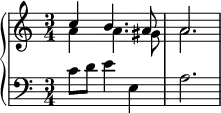Corelli cadence
The Corelli cadence, or Corelli clash, named for its association with the violin music of the Corelli school, is a cadence characterized by a major and/or minor second clash between the tonic and the leading-tone or the tonic and supertonic. The cadence is found as early as 1634 in Steffano Landi's Il Sant'Alessio[1] whereas Corelli was born in 1653. It has been described as cliché.[2]

Corelli clash in a cadence on G ⓘ.[1]

A Corelli clash in a cadence on A
This is created by the voice leading concerns of modal music, specifically the use of anticipation during cadences.[3] The English cadence is another "clash cadence".
See also
References
- Apel, Willi and Binkley, Thomas (1990). Italian Violin Music of the Seventeenth Century, p.56. ISBN 0-253-30683-3.
- Julie Anne Sadie, ed (1998). Companion to Baroque Music, p.61. ISBN 0-520-21414-5.
- Latham, Alison, ed. (2002). The Oxford Companion to Music, p.192. ISBN 0-19-866212-2.
This article is issued from Wikipedia. The text is licensed under Creative Commons - Attribution - Sharealike. Additional terms may apply for the media files.